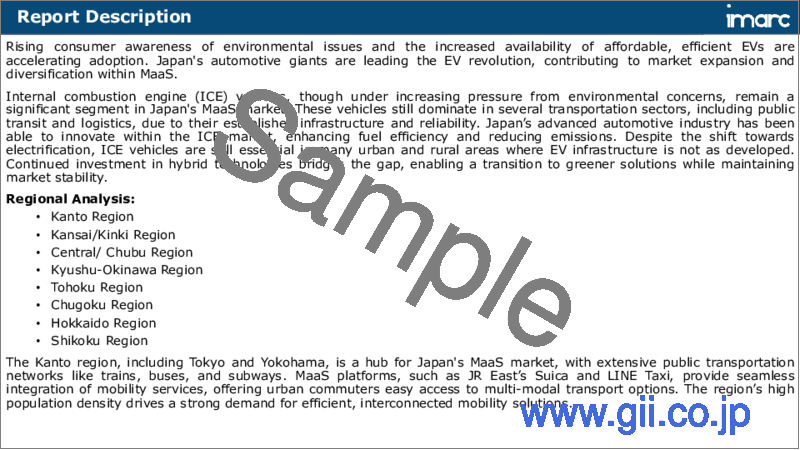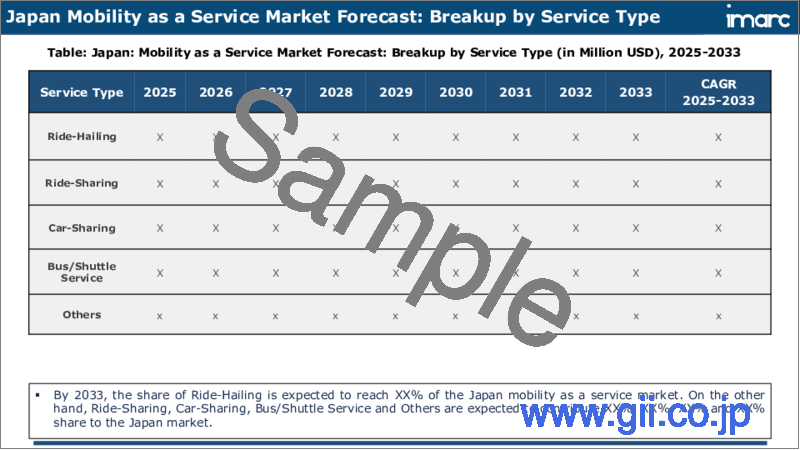|
|
市場調査レポート
商品コード
1609788
日本のMaaS(Mobility as a Service)市場レポート:サービスタイプ別、輸送タイプ別、アプリケーションプラットフォーム別、推進タイプ別、地域別、2025年~2033年Japan Mobility as a Service Market Report by Service Type, Transportation Type, Application Platform, Propulsion Type, and Region 2025-2033 |
||||||
カスタマイズ可能
|
|||||||
| 日本のMaaS(Mobility as a Service)市場レポート:サービスタイプ別、輸送タイプ別、アプリケーションプラットフォーム別、推進タイプ別、地域別、2025年~2033年 |
|
出版日: 2024年12月05日
発行: IMARC
ページ情報: 英文 117 Pages
納期: 5~7営業日
|
全表示
- 概要
- 目次
日本のMaaS(Mobility as a Service)市場の市場規模は2024年に4億2,900万米ドルに達しました。今後、IMARC Groupは、市場は2033年までに95億8,100万米ドルに達し、2025年から2033年の間に41.2%の成長率(CAGR)を示すと予測しています。大手企業によるブロックチェーン技術の採用拡大が、主に市場成長を牽引しています。
本レポートで回答した主な質問
- 日本のMaaS(Mobility as a Service)市場はこれまでどのように推移し、今後どのように推移するのか?
- COVID-19が日本のMaaS(Mobility as a Service)市場に与えた影響は?
- 日本のMaaS(Mobility as a Service)市場のサービスタイプ別構成比は?
- 日本のMaaS(Mobility as a Service)市場の輸送タイプ別の内訳は?
- 日本のMaaS(Mobility as a Service)市場のアプリケーションプラットフォーム別の内訳は?
- 日本のMaaS(Mobility as a Service)市場の推進タイプ別の内訳は?
- 日本のMaaS(Mobility as a Service)市場のバリューチェーンにはどのような段階がありますか?
- 日本のMaaS(Mobility as a Service)の主な促進要因と課題は何か?
- 日本のMaaS(Mobility as a Service)市場の構造と主要プレーヤーは?
- 日本のMaaS(Mobility as a Service)市場における競合の程度は?
目次
第1章 序文
第2章 調査範囲と調査手法
- 調査の目的
- ステークホルダー
- データソース
- 市場推定
- 調査手法
第3章 エグゼクティブサマリー
第4章 日本のMaaS(Mobility as a Service)市場:イントロダクション
- 概要
- 市場力学
- 業界動向
- 競合情報
第5章 日本のMaaS(Mobility as a Service)市場情勢
- 過去および現在の市場動向(2019年~2024年)
- 市場予測(2025-2033)
第6章 日本のMaaS(Mobility as a Service)市場:サービスタイプ別の内訳
- ライドヘイリング
- ライドシェア
- カーシェアリング
- バス/シャトルサービス
- その他
第7章 日本のMaaS(Mobility as a Service)市場:輸送手段別の内訳
- 民間
- 公共
第8章 日本のMaaS(Mobility as a Service)市場:アプリケーションプラットフォーム別の内訳
- Android
- iOS
- その他
第9章 日本のMaaS(Mobility as a Service)市場:推進タイプ別の内訳
- 電気自動車
- 内燃機関
- その他
第10章 日本のMaaS(Mobility as a Service)市場:競合情勢
- 概要
- 市場構造
- 市場プレーヤーのポジショニング
- 主要成功戦略
- 競合ダッシュボード
- 企業評価象限
第11章 主要企業のプロファイル
第12章 日本のMaaS(Mobility as a Service)市場:業界分析
- 促進要因・抑制要因・機会
- ポーターのファイブフォース分析
- バリューチェーン分析
第13章 付録
Japan mobility as a service market size reached USD 429 Million in 2024. Looking forward, IMARC Group expects the market to reach USD 9,581 Million by 2033, exhibiting a growth rate (CAGR) of 41.2% during 2025-2033. The growing adoption of blockchain technology by leading players is primarily driving the market growth.
Mobility as a service (MaaS) is a consumer-oriented transportation model designed to enhance accessibility, inclusivity, and sustainability in mobility. This approach encompasses an on-demand transportation platform that incorporates a wide range of services, including cars, public transit, taxis, bike sharing, ride-sharing, and various rental options. It operates through a user-friendly digital interface that manages and integrates bookings, electronic ticketing, comprehensive trip planning, and payment services. MaaS also collaborates with data services to enhance the customer experience by providing real-time updates on transportation routes, delays, weather conditions, fares, and other relevant information. It brings added convenience, ensures a seamless mobility journey, reduces reliance on private vehicles, offers personalized options, and contributes to mitigating traffic congestion.
Japan Mobility as a Service Market Trends:
The mobility as a service market in Japan is rapidly evolving and reshaping the way people access and utilize transportation services. In Japan, MaaS encompasses a wide spectrum of transportation options seamlessly integrated into a single digital platform. This platform allows users to plan, book, and pay for their entire journey, utilizing a combination of services such as public transit, taxis, ridesharing, bike sharing, and even car rentals. The convenience of a unified platform enhances the overall transportation experience, encouraging individuals to explore alternatives to private car ownership. Japan's mobility as a service market is driven by a combination of factors, including its commitment to reducing traffic congestion, promoting eco-friendly transportation options, and addressing the unique mobility needs of an aging population. The regional market also leverages data services to provide real-time updates on routes, schedules, pricing, and weather conditions, further enhancing user convenience. As a result, MaaS is not only transforming the way people move within Japan but also contributing to the nation's goals of sustainability, reduced carbon emissions, and improved transportation accessibility for all. This, in turn, is projected to fuel the market growth in the coming years.
Japan Mobility as a Service Market Segmentation:
Service Type Insights:
- Ride-Hailing
- Ride-Sharing
- Car-Sharing
- Bus/Shuttle Service
- Others
Transportation Type Insights:
- Private
- Public
Application Platform Insights:
- Android
- iOS
- Others
Propulsion Type Insights:
- Electric Vehicle
- Internal Combustion Engine
- Others
Competitive Landscape:
The market research report has also provided a comprehensive analysis of the competitive landscape. Competitive analysis such as market structure, key player positioning, top winning strategies, competitive dashboard, and company evaluation quadrant has been covered in the report. Also, detailed profiles of all major companies have been provided.
Key Questions Answered in This Report:
- How has the Japan mobility as a service market performed so far and how will it perform in the coming years?
- What has been the impact of COVID-19 on the Japan mobility as a service market?
- What is the breakup of the Japan mobility as a service market on the basis of service type?
- What is the breakup of the Japan mobility as a service market on the basis of transportation type?
- What is the breakup of the Japan mobility as a service market on the basis of application platform?
- What is the breakup of the Japan mobility as a service market on the basis of propulsion type?
- What are the various stages in the value chain of the Japan mobility as a service market?
- What are the key driving factors and challenges in the Japan mobility as a service?
- What is the structure of the Japan mobility as a service market and who are the key players?
- What is the degree of competition in the Japan mobility as a service market?
Table of Contents
1 Preface
2 Scope and Methodology
- 2.1 Objectives of the Study
- 2.2 Stakeholders
- 2.3 Data Sources
- 2.3.1 Primary Sources
- 2.3.2 Secondary Sources
- 2.4 Market Estimation
- 2.4.1 Bottom-Up Approach
- 2.4.2 Top-Down Approach
- 2.5 Forecasting Methodology
3 Executive Summary
4 Japan Mobility as a Service Market - Introduction
- 4.1 Overview
- 4.2 Market Dynamics
- 4.3 Industry Trends
- 4.4 Competitive Intelligence
5 Japan Mobility as a Service Market Landscape
- 5.1 Historical and Current Market Trends (2019-2024)
- 5.2 Market Forecast (2025-2033)
6 Japan Mobility as a Service Market - Breakup by Service Type
- 6.1 Ride-Hailing
- 6.1.1 Overview
- 6.1.2 Historical and Current Market Trends (2019-2024)
- 6.1.3 Market Forecast (2025-2033)
- 6.2 Ride-Sharing
- 6.2.1 Overview
- 6.2.2 Historical and Current Market Trends (2019-2024)
- 6.2.3 Market Forecast (2025-2033)
- 6.3 Car-Sharing
- 6.3.1 Overview
- 6.3.2 Historical and Current Market Trends (2019-2024)
- 6.3.3 Market Forecast (2025-2033)
- 6.4 Bus/Shuttle Service
- 6.4.1 Overview
- 6.4.2 Historical and Current Market Trends (2019-2024)
- 6.4.3 Market Forecast (2025-2033)
- 6.5 Others
- 6.5.1 Historical and Current Market Trends (2019-2024)
- 6.5.2 Market Forecast (2025-2033)
7 Japan Mobility as a Service Market - Breakup by Transportation Type
- 7.1 Private
- 7.1.1 Overview
- 7.1.2 Historical and Current Market Trends (2019-2024)
- 7.1.3 Market Forecast (2025-2033)
- 7.2 Public
- 7.2.1 Overview
- 7.2.2 Historical and Current Market Trends (2019-2024)
- 7.2.3 Market Forecast (2025-2033)
8 Japan Mobility as a Service Market - Breakup by Application Platform
- 8.1 Android
- 8.1.1 Overview
- 8.1.2 Historical and Current Market Trends (2019-2024)
- 8.1.3 Market Forecast (2025-2033)
- 8.2 iOS
- 8.2.1 Overview
- 8.2.2 Historical and Current Market Trends (2019-2024)
- 8.2.3 Market Forecast (2025-2033)
- 8.3 Others
- 8.3.1 Historical and Current Market Trends (2019-2024)
- 8.3.2 Market Forecast (2025-2033)
9 Japan Mobility as a Service Market - Breakup by Propulsion Type
- 9.1 Electric Vehicle
- 9.1.1 Overview
- 9.1.2 Historical and Current Market Trends (2019-2024)
- 9.1.3 Market Forecast (2025-2033)
- 9.2 Internal Combustion Engine
- 9.2.1 Overview
- 9.2.2 Historical and Current Market Trends (2019-2024)
- 9.2.3 Market Forecast (2025-2033)
- 9.3 Others
- 9.3.1 Historical and Current Market Trends (2019-2024)
- 9.3.2 Market Forecast (2025-2033)
10 Japan Mobility as a Service Market - Competitive Landscape
- 10.1 Overview
- 10.2 Market Structure
- 10.3 Market Player Positioning
- 10.4 Top Winning Strategies
- 10.5 Competitive Dashboard
- 10.6 Company Evaluation Quadrant
11 Profiles of Key Players
- 11.1 Company A
- 11.1.1 Business Overview
- 11.1.2 Product Portfolio
- 11.1.3 Business Strategies
- 11.1.4 SWOT Analysis
- 11.1.5 Major News and Events
- 11.2 Company B
- 11.2.1 Business Overview
- 11.2.2 Product Portfolio
- 11.2.3 Business Strategies
- 11.2.4 SWOT Analysis
- 11.2.5 Major News and Events
- 11.3 Company C
- 11.3.1 Business Overview
- 11.3.2 Product Portfolio
- 11.3.3 Business Strategies
- 11.3.4 SWOT Analysis
- 11.3.5 Major News and Events
- 11.4 Company D
- 11.4.1 Business Overview
- 11.4.2 Product Portfolio
- 11.4.3 Business Strategies
- 11.4.4 SWOT Analysis
- 11.4.5 Major News and Events
- 11.5 Company E
- 11.5.1 Business Overview
- 11.5.2 Product Portfolio
- 11.5.3 Business Strategies
- 11.5.4 SWOT Analysis
- 11.5.5 Major News and Events
12 Japan Mobility as a Service Market - Industry Analysis
- 12.1 Drivers, Restraints, and Opportunities
- 12.1.1 Overview
- 12.1.2 Drivers
- 12.1.3 Restraints
- 12.1.4 Opportunities
- 12.2 Porters Five Forces Analysis
- 12.2.1 Overview
- 12.2.2 Bargaining Power of Buyers
- 12.2.3 Bargaining Power of Suppliers
- 12.2.4 Degree of Competition
- 12.2.5 Threat of New Entrants
- 12.2.6 Threat of Substitutes
- 12.3 Value Chain Analysis






